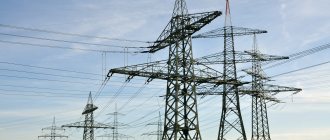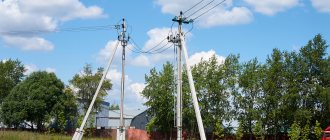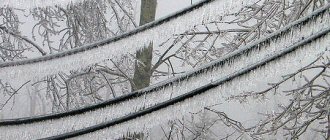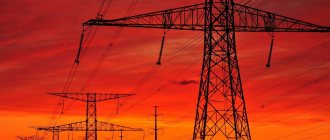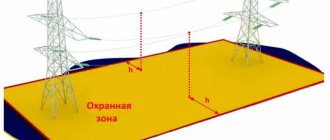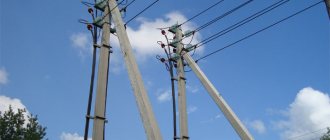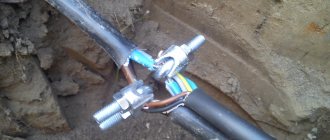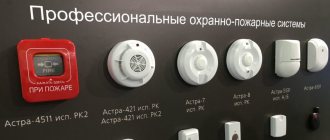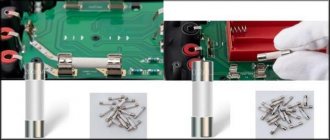A complete list of overhead line supports presented on our website can be found on the tabs below. Select first the material from which the pole is made, and then the line voltage rating. After this, go to the page with the list of overhead line supports. Please note that the list of supports is constantly updated.
Wooden overhead line supports
- VL-0.4 kV
- VL-6.10 kV
- VL-35kV
- VL-110kV
- VL-220kV
Reinforced concrete supports for overhead lines
- VL-0.4 kV
- VL-6.10 kV
- VL-35kV
- VL-110kV
- VL-220kV
- VL-330kV
Metal supports for overhead lines
- VL-6.10 kV
- VL-35kV
- VL-110kV
- VL-220kV
- VL-330kV
Power line supports are perhaps one of the most complex elements of power lines. When designing and constructing these structures, it is necessary to take into account both the climatic and soil characteristics of the area. Currently, pole manufacturers are striving to reduce the cost of production and increase the strength characteristics of products.
In view of this, various designs are being developed to reduce the load on the foundation and ensure stable operation in various operating modes.
On our website you can familiarize yourself with both old and new developments of Russian engineers.
Wooden supports
They are usually made from pine logs with the bark removed. For power lines with supply voltages up to 1000 V, it is also possible to use other tree species, for example, fir, oak, cedar, spruce, and larch. Logs that will subsequently become power line supports must meet certain technical requirements. The natural taper of the trunk, in other words, the change in its diameter from the thick lower end (butt) to the upper cut should not exceed 8 mm per 1 meter of log length. The diameter of the log on the upper cut for lines with voltage up to 1000 V is taken to be at least 12 cm, for lines with voltage above 1000 V, but not higher than 35 kV - 16 cm, and for lines with higher voltage at least 18 cm.
Wooden supports can be used for the construction of overhead lines with a voltage not exceeding 110 kV inclusive. Wooden supports are most widely used in overhead lines with voltages up to 1000 V, as well as in communication lines. The advantage of wooden supports is their relatively low cost and ease of manufacture. However, there is a minus, a significant minus - they are susceptible to rotting and the service life of pine supports is about 4-5 years. To protect wood from rotting, it is impregnated with special antiseptics against rotting, for example anthracene or creosote oil. Those parts that will be dug into the ground, as well as cutting ends, braces and traverses, lend themselves to especially careful processing. Thanks to antiseptics, the service life increases by about 2-3 times. For the same purpose, quite often the legs of a wooden electrical support are made of two parts - the main stand and the chair (stepchild):
Where – 1) the main stand, and 2) a chair (stepchild)
If the lower part is severely rotted, it is enough to replace only the stepson.
Bottom line
Having studied the above material, we can summarize that the presence of a person near lines with voltages above 1 kV not only affects a person’s well-being, but can also cause significant harm to his health. Therefore, in case of forced stay near high-voltage power lines, a person must minimize his time in dangerous areas.
If the line is located in close proximity to your home and you are not sure of the safety of the proximity to the power line, then specialized measurements should be made. Which can be performed by organizations with the appropriate level of qualifications and equipment. They will check the compliance of the electromagnetic background in your home with sanitary standards.
Sources used:
- https://www.elibrary.ru/item.asp?id=35368561
- https://www.niehs.nih.gov/health/topics/agents/emf/
- https://publications.iarc.fr/98
Metal supports
Plus - durable and reliable in operation. Minus - a large consumption of metal is required, which entails a significant increase in cost (compared to wooden ones). Metal supports of overhead power lines are used, as a rule, at voltages from 110 kV, since the operation of metal supports involves high costs for performing very labor-intensive and expensive work on periodic painting, which protects against corrosion.
Rules and regulations for installing power transmission line supports
The first step in installing all types of overhead line supports will be design. The installation of electricity poles must be carried out in accordance with a given project, taking into account all technical standards, from the type of poles to the characteristics of the soil, the specifics of the landscape, proximity to residential buildings and buildings for other purposes.
The financial costs of installation depend on the literacy of the project. At this stage, the types of overhead line supports for electricity are selected. They also calculate the foundation, which will serve as the basis for installing the supports. To carry out installation work, it is important to use all kinds of specialized equipment, which is necessary to transport supports to the site, move and lift them, and drill wells.
The assembly and installation of supports is a multi-step process that includes laying them out, installing them in the required position and fixing them. Layout, according to the standards, is carried out along the axis of the overhead line.
Each type of work when installing an overhead line support must be entrusted to a special team that can competently perform the following operations:
- Layout of wires along the route, their installation on supporting garlands and connection. During assembly, pin insulators are also mounted on the supports; I do this immediately before installation begins.
- Tensioning of cables with sighting, adjustment of sag arms, fixation of wires with anchor supports.
- Fastening the wires to the supports (clamps are used).
There are other subtleties in installing supports. For example, after constructing a pit, the installation of the support must be carried out within 1 day, with mandatory fixation using guy wires and subsequent fastening of the crossbars. Due to the huge number of subtleties associated with the installation of supports and the need for specialized equipment, their installation can only be done by professional teams.
Reinforced concrete supports
In the industrial manufacturing process, they are the most optimal option for overhead lines both up to 1000 V and above 1000 V. The use of reinforced concrete supports dramatically reduces operating costs, since they practically do not require repairs. Currently, almost everywhere, reinforced concrete supports are used in the construction of overhead lines of 6-10 kV and up to 110 kV. They are especially widespread in urban networks up to and above 1000 V. Reinforced concrete supports can be made either monolithic (cast) or in the form of assemblies, which are assembled directly at the installation site. Their strength depends on the method of concrete compaction, of which there are two - centrifugation and vibration. When using the centrifugation method, a good density of concrete is obtained, which subsequently has a good effect on the finished product.
On overhead power lines, special anchor, corner, end, and intermediate supports are used.
Classification by materials of manufacture
The structures are installed in various climatic and geoseismic conditions. It is worth noting that many types of supports are designed for use in urban areas. Thus, in each case it is necessary to use suitable material for the manufacture of racks.
Wooden supports
Wooden power transmission line supports are widespread in rural areas, but do not forget that the corresponding wooden structures are also used on lines up to 220 kV.
Wood structures are most often used on low voltage lines, and they have a number of advantages:
- relative durability (up to 50 years with appropriate impregnation);
- light weight;
- ease of construction and transportation;
- low cost.
Reinforced concrete supports
Reinforced concrete supports are installed on lines with voltages less than 500 kV. Basically, these are intermediate supports that do not take the load from the tension of wires and cables. If reinforced concrete racks are used as anchor supports, they are strengthened with bevels or braces.
Reinforced concrete supports are made from prestressed reinforced concrete and have a number of advantages:
- simple design features;
- do not require complex additional assembly;
- are not subject to rotting like wooden supports;
- in some cases it is possible to install directly into the ground;
- relatively simple construction of the line.
Steel supports
Steel supports on 0.4-10 kV lines are installed extremely rarely. Their prerogative is medium voltage lines and higher. Metal supports are mainly used as anchor supports, however, when the network voltage is more than 110 kV, intermediate steel supports are also used.
The structures can be made either from profiles and corners, or by rolling, since metal supports based on pipes are often used in lighting. Among the advantages of supports of this type are their wear resistance and durability, as well as the ability to manufacture very high structures to ensure safe passage through engineering structures and natural barriers.
Anchor supports
Their purpose is to rigidly secure wires and lines to them. The location for their installation is determined by the project. By design, the anchor support must be strong, since if a wire breaks on one side, it must withstand the mechanical load of the wires on the other side of the line.
Anchor spans are the distance between anchor supports. On straight sections (depending on the cross-section of the wires), anchor spans are up to 10 km long.
Harm to technology and means of communication
Also, damage from power lines is observed at nearby electrical installations; overhead line devices and communication lines are especially susceptible to the influence. Obvious harm for them is expressed in the induction of excess potential at frequencies close to or equal to the frequency of signal transmission. What causes interference or distortion of transmitted data. For devices in a grounded metal casing, the damage to power lines will be insignificant, since the outer casing acts as a natural shield.
A separate issue is the damage caused to underground communications, in particular pipelines. In the case of close proximity of power lines, an EMF occurs on the conductive surface of the pipeline, causing metal removal and premature corrosion destruction. In addition, an underground electrical pipe can cause electric shock to a person. Therefore, they are also trying to secure them with the help of UZTs, which provide safe underground crossings or parallel laying along power lines.
Special supports
They are electric poles of increased height and are used at intersections of power transmission lines with highways and railways, rivers, intersections between power lines themselves, and in other cases when the standard height of electric poles is not enough to ensure the required distance to the wires. Intermediate electrical supports for lines with voltages up to 10 kV are made single-post (candle-shaped). In low-voltage networks, single-post supports perform the functions of corner or end supports, and are also equipped additionally with guy wires attached to the side opposite to the tension of the wires, or with struts (supports) that are installed on the side of the tension of the wires:
For lines with a voltage of 6-10 kV, electrical supports are made A-shaped:
Air lines are also characterized by their main dimensions and dimensions.
Overhead line dimension is the vertical distance from the lowest point of the wire to the ground or water.
The sag is the distance between the imaginary straight line between the wire attachment points on the support and the lowest point of the wire in the span:
All dimensions of power lines are strictly regulated by the PUE and directly depend on the value of the supply voltage, as well as the terrain through which the route passes.
The PUE also regulates other dimensions when crossing and approaching power lines, both among themselves and between communication lines, highways and railways, overhead pipelines, and cable cars.
To check the designed power line to the requirements of the PUE, mechanical strength calculations are performed, the methods of which are given in special courses on electrical networks.
Impact on the environment and ecology
In addition to the impact on humans, harm from power lines also affects other living organisms. Thus, plants growing near power line supports and along the entire length of high-voltage wires begin to change. In some cases, the deviation of shoots and branches away from the line is clearly manifested, in others, branches atypical for a particular type occur, changes in the structure of the plant, etc. However, at the same time, some agricultural crops and fruit-bearing trees under the influence of power lines produce better yields and increase the formation of seeds.
Representatives of the animal world feel the impact and harm from passing power lines and try not to approach them at an unacceptable distance, sticking to pastures away from the lines. Electromagnetic radiation poses a particularly significant danger to artiodactyl fauna, since the hooves represent a layer of insulation that prevents the charge from flowing to the ground. Because of this, a significant potential can be induced in the animal’s body, which will be discharged at the first touch to the grass or tree leaves.
Rice. 4. Impact of power lines on artiodactyl animals
In relation to insects, a particularly strong reaction is observed between power lines and bees. Since in the case of the location of the hives directly below the line, the activity of individuals, honey collection and offspring are significantly reduced. In some cases, the death of queens that do not leave their habitat is observed.
